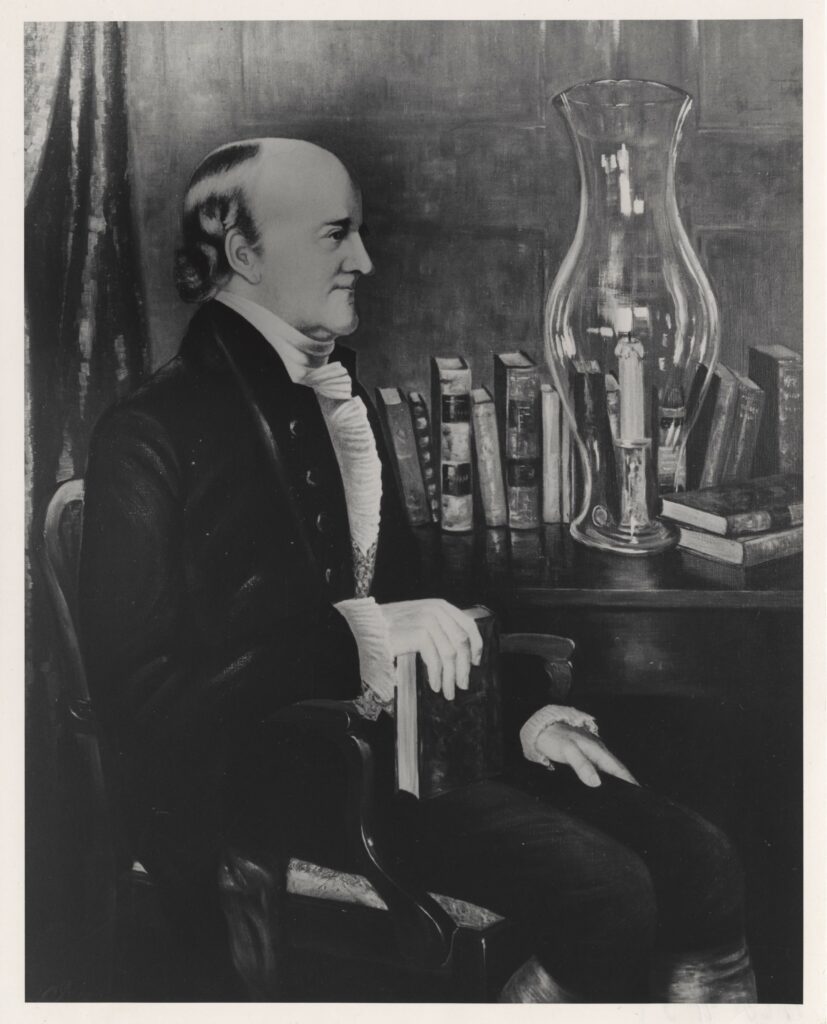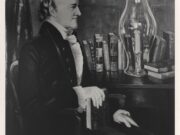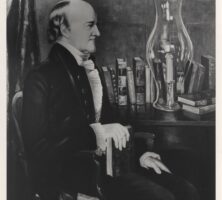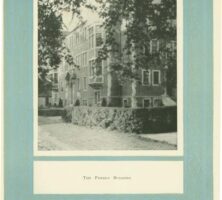The history of physics in Georgia uniquely portrays the regional, national, and international impact that the state’s colleges and universities continue to make in research, development, and education. Josiah Meigs, the second president of the University of Georgia, implemented the state’s first physics curriculum in 1801, using sophisticated equipment manufactured at the time only in Europe. The pioneer spirit of bold innovation grounded in outstanding scientific expertise continues to thrive today, especially in the world-class research centers located at the Georgia Institute of Technology and Clark Atlanta University.
University of Georgia
“Natural Philosophy”
Interest in physics began early at the University of Georgia in Athens. In 1800 Abraham Baldwin, the university’s first president, was given $1,000 for the purchase of books and equipment. The university attached great significance to “natural philosophy” (used in a broad sense, including the physical sciences) and adopted it into the original curriculum.

Courtesy of Hargrett Rare Book and Manuscript Library, University of Georgia Libraries.
The university’s second president, Josiah Meigs, vigorously dedicated himself to developing the natural philosophy program. Meigs, born in Middletown, Connecticut, graduated from Yale in 1778. Though best known for his mathematical ability, he studied a breadth of subjects, ranging from theology to metaphysics, at Yale. After practicing law, he was hired at Yale as a professor of mathematics and natural philosophy in 1794. However, because the Federalist majority of the faculty disapproved of his friendship with Thomas Jefferson, Meigs left the university in 1800.
It was precisely this mixture of great scholastic ability, coupled with a relative lack of political dexterity, that distinguished Meigs’s tenure as president of the University of Georgia. During most of his service he was the only professor of natural philosophy and taught all of its subjects, while distinguishing himself with considerable research in meteorology and astronomy. Conflicts with members of the board of trustees, some of whom disdained Meigs’s Jeffersonian outlook and secular approach to education, eventually forced Meigs to resign from the presidency in 1810, but he stayed on as a professor for another year.
Nineteenth and Early Twentieth Centuries
Thanks to Meigs, few, if any, institutions across the country were as well equipped as the University of Georgia. Almost all experimental equipment purchases were made in Europe, and the highlights of the trustees’ annual meetings include an inspection of the many apparatuses collected by the university. By the latter half of the nineteenth century, the inventory included a telescope, an Archimedean spiral, and a duplicate of Benjamin Franklin’s kite apparatus.
Beginning with Meigs, the physics department also enjoyed a high degree of collaboration with scientists in France. The first professor specifically hired to teach physics at the university was Henry Jackson in 1811. While on leave for service at the American embassy in France, Jackson purchased much of the department’s laboratory equipment there. French-born Colonel Leon Henri Charbonnier, one of the university’s most celebrated nineteenth-century scholars, served as chair from 1877 to 1897.
Other celebrated members of the faculty included Andrew H. Patterson (1894-1908) and Linville Laurentine Hendren
Department of Physics and Astronomy
In 1887 the Department of Natural Philosophy became the Department of Physics and Astronomy. The research aim and structure of the department was largely conceived and implemented by Ellis Dixon, department head from 1937 to 1967, who emphasized particularly the central role of basic research. During his tenure, the department launched a modern and comprehensive research department, with a strong emphasis on nuclear physics, molecular spectroscopy, astronomy, and astrophysics, by purchasing a two-million-volt Van de Graaff accelerator and a twenty-four-inch reflecting telescope in 1960-61.
Today, the strength of basic research shows itself in the numerous interdisciplinary research centers and research groups within the department. Such research centers include the Center for Simulational Physics, the National Ultraviolet Monitoring Center (NUVMC), and the Nanoscale Science and Engineering Center (NanoSEC). The Simulational Physics Center engages in cutting-edge computational physical research, simulating phenomena from the nuclear to the galactic. The NUVMC, in cooperation with the Environmental Protection Agency, monitors ultraviolet emissions from the sun across all parts of the country. NanoSEC, with faculty from nine departments and four colleges, actively incorporates basic and applied research in developing technology at atomic and molecular scales.
Georgia Institute of Technology
Early Developments
The Georgia Institute of Technology in Atlanta was formed on October 13, 1885. At the outset, Georgia Tech closely modeled itself after the Worcester “Free School” in Worcester, Massachusetts (now the Worcester Polytechnic Institute) and the Massachusetts Institute of Technology in Cambridge. The curricula of such schools emphasized primarily an amalgamation of undergraduate physics education with engineering.
In the 1920s and 1930s the physics department, under the directorship of J. B. Edwards, was closely tied to applied research connected with public and private companies. The nature of such research indicates the transformation of research and development exemplified by the new technical schools. Yet aside from demonstrating the nascent trend in corporate-institute partnerships, such research grants also indicate the relative obscurity faced by the physics profession in those days. There was general controversy and confusion concerning the precise nature of such work, some calling it mathematics and others engineering. Only after World War II (1941-45) did physics rise to higher prominence and thus distinguish itself in its own right.

Courtesy of Georgia Institute of Technology Library and Information Center.
School of Physics
During the latter decades of the twentieth century, research at the Georgia Institute of Technology began to distinguish itself in breadth and scope. The internationally renowned groups specialize in applied, interdisciplinary, and pure research. The applied and interdisciplinary centers include the Center for Nonlinear Science (CNS), which
In terms of pure research, David Finkelstein
Clark Atlanta University
Clark Atlanta University in Atlanta harbors a distinguished community of world-class mathematicians and theoretical physicists. J. Ernest
CTSPS enjoys an international reputation in areas ranging from wavelet theory to molecular dynamics and computational physics. It also plays an essential international role through the development of physics in sub-Saharan nations. Along with its Belgian and French collaborators, CTSPS researchers hold fully institutionalized conferences every other year in Contonou, Benin.
Southeastern Section of the American Physical Society
During the 1930s, physicists in the Southeast felt generally handicapped by logistics and location. Shoestring budgets, which got even smaller during the Great Depression, prevented many from acquiring appropriate travel funds. The most important professional organization at the time, as it is today, was the American Physical Society (APS), founded in 1899. Most of its members, however, worked in the Northeast.
After moving to Nashville, Francis Slack organized about 100 physicists based in the Southeast for a conference, which was held in 1935 at Emory University in Atlanta.
In 1936 the organization’s name changed to the American Society of Physicists (ASP), to avoid possible confusion with the APS. Eventually, in a meeting held jointly at Duke University in Durham, North Carolina, and the University of North Carolina, the ASP was admitted into the APS and renamed the Southeastern Section of the American Physical Society (SESAPS). The organization rose quickly to prominence, as researchers in the strongest departments of physics in the Southeast (Duke University, University of North Carolina, the University of Virginia in Charlottesville, and later Vanderbilt University) submitted the highest number of papers for the yearly conferences. The SESAPS conferences grew in prominence and drew national attention.
Physicists from Georgia Tech exhibited a strong presence at the centennial APS meeting held in March 1999 in Atlanta. Some of the most important contributors of our time, including Stephen Hawking, presented their results to a diverse international audience at the conference.
From the pioneering work of Josiah Meigs to the present, Georgia has had a regional and an international impact in this most fundamental science. Its presence can only increase as its institutions continue to grow in size and prestige.







